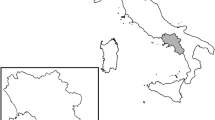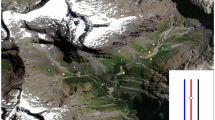Abstract
The study of winter-active small mammals beneath the snowpack has proved challenging for researchers because of the relative inaccessibility. We present a technique using hair tubes that permits the detection of small mammals active in the subnivean space. Hair tubes are cylindrical or funnel-shaped structures containing suitable bait and an adhesive surface that harvests hairs from small mammals as they attempt to reach the bait. Hair tubes eliminate many of the difficulties often associated with live trapping and permit the expansion of systematic sampling to larger scales than allowed by conventional live-trapping methods. The technique was used successfully to detect five small mammal species in the subnivean space in Kosciuszko National Park (KNP) in southeastern Australia. These included the common bush-rat, Rattus fuscipes; the dusky and agile antechinus, Antechinus swainsonii and A. agilis; the broad-toothed rat, Mastacomys fuscus; and the mountain pygmy possum, Burramys parvus. Although hair tubes have a number of limitations, such as not providing a measure of abundance or allowing the identification of individual animals, we believe that these limitations are balanced by the fact that the technique can be used at any spatial scale. Hair tubes are particularly suited to studies of animal distribution at the landscape-scale, because many hair tubes can be deployed and dispersed over large areas, and monitored on a regular basis by a small team of researchers. The technique also makes use of readily available, low-cost materials and could be easily adapted to a range of conditions and different target species.



Similar content being viewed by others
References
Beuch R (1974) A new live-trap and techniques for winter trapping of small mammals. Can Field Nat 88:317–321
Brunner H, Coman B (1974) The identification of mammalian hair. Inkata Press, Melbourne
Brunner H, Triggs B (2002) Hair ID: an interactive tool for identifying Australian mammalian hair, CD-Rom. Ecobyte, CSIRO Publishing, Melbourne
Bubela TM, Happold DCD, Broome LS (1991) Home range and activity of the broad-toothed rat, Mastacomys fuscus, in subalpine heathland. Wildl Res 18:39–48
Carron PL (1985) The ecology of three species of small mammals in subalpine habitat. PhD Thesis, Australian National University, Canberra
Cranford JA (1984) Population ecology and home range utilizations of two subalpine meadow rodents (Microtus longicaudus and Peromyscus maniculatus). In: Merritt JF (ed) Winter ecology of small mammals. Special publication No. 10. Carnegie Museum of Natural History, Pittsburgh, pp 285–291
Dickman CR (1995) Dusky antechinus. In: Strahan R (ed) The Australian Museum complete book of Australian mammals. Reed Books, Chatswood, pp 46–47
Dickman CR, Green K, Carron PL, Happold DCD, Osborne WS (1983) Coexistence, convergence and competition among antechinus (Marsupialia) in the Australian high country. Proc Ecol Soc Aust 12:79–99
Fay FH (1960) Technique for trapping small tundra mammals in winter. J Mammal 41:141–142
Formozov AN (1946) Snow cover as an integral factor of the environment and its importance in the ecology of mammals and birds. Boreal Institute, Edmonton
Green K (1988) A study of Antechinus swainsonii and Antechinus stuartii and their prey in the Snowy Mountains. PhD Thesis, Australian National University, Canberra
Green K (1997) Inter-annual, seasonal and altitudinal differences in invertebrate activity in the Snowy Mountains. Victorian Nat 114:222–229
Green K, Osborne WS (1994) Wildlife of the Australian snow country. Reed Books, Chatswood
Happold DCD (1995) Broad-toothed rat. In: Strahan R (ed) The Australian Museum complete book of Australian mammals. Reed Books, Chatswood
Iverson SL, Turner BN (1969) Under snow shelter for small mammal trapping. J Wildl Manage 33:722–723
Keller BL, Groves CR, Pitcher EJ, Smolen MJ (1982) A method to trap rodents in snow, sleet or rain. Can J Zool 60:1104–1106
Laidlaw WS, Wilson BA (1989) Distribution and habitat preference of small mammals in the eastern section of the Angahook-Lorne state park. Victorian Nat 106:224–236
Lindenmayer DB, Cunningham RB, Donnelly CF, Triggs BE, Belvedere M (1994) Factors influencing the occurrence of mammals in retained linear strips (wildlife corridors) and contiguous stands of montane ash forest in the central highlands of Victoria, southeastern Australia. For Ecol Manage 67:113–133
Lindenmayer DB, Cunningham RB, Pope ML (1999a) A large-scale “experiment” to examine the effects of landscape context and habitat fragmentation on mammals. Biol Conserv 88:387–403
Lindenmayer DB, Incoll RD, Cunningham RB, Pope ML, Donnelly CF, MacGregor CI, Tribolet C, Triggs BE (1999b) Comparison of hairtube types for the detection of mammals. Wildl Res 26:745–753
Lunney D (1995) Bush rat. In: Strahan R (ed) The Australian Museum complete book of Australian mammals. Reed Books, Chatswood
Mansergh I (1985) A technique for trapping under the snow in alpine environments. Victorian Nat 102:55–57
Mayer MV (1952) The hair of Californian mammals with keys to the dorsal guard hairs of Californian mammals. Am Midland Nat 48:480–512
Merritt JF (1984) Growth patterns and seasonal thermogenesis of Cletherinomys gapperi inhabiting the Appalachian and Rocky Mountains of North America. In: Merritt JF (ed) Winter ecology of small mammals. Special publication No. 10. Carnegie Museum of Natural History, Pittsburgh, pp 201–213
Merritt JF, Merritt JM (1978) Population ecology and energy relationships of Clethrionomys gapperi in a Colorado subalpine forest. J Mammal 59:576–598
Mills DJ, Harris B, Claridge AW, Barry SC (2002) Efficacy of hair-sampling techniques for the detection of medium-sized terrestrial mammals. I. A comparison between hair-funnels, hair-tubes and indirect signs. Wildl Res 29:379–387
Moore JE (1988) A key for the identification of animal hairs. J Forensic Sci Soc 28:335–339
Pruitt WO Jr (1957) Observations on the bioclimate of some taiga mammals. Arctic 10:129–138
Pruitt WO Jr (1959) A method of live-trapping small taiga mammals in winter. J Mammal 40:139–143
Pruitt WO Jr (1960) Animals in the snow. Sci Am 202:61–68
Pruitt WO Jr (1984) Snow and small animals. In: Merritt JF (ed) Winter ecology of small mammals. Special Publication of Carnegie Museum of Natural History, Pittsburgh, pp 1–8
Sanecki GM (1999) The effects of linear disturbances on the movement behaviour of small mammals in Kosciuszko National Park. Honours Dissertation, Charles Sturt University, Wagga Wagga
Scotts DJ, Craig SA (1988) Improved hair-sampling tube for the detection of rare mammals. Aust Wildl Res 15:469–472
Scotts DJ, Seebeck JH (1989) Ecology of Potorous longipes (Marsupialia: Potoroidae); with preliminary recommendations for management of its habitat in Victoria. Arthur Rylah Institute for Environmental Research Technical Report Series No. 62. Department of Conservation and Environment, Victoria
Soper JD (1944) On the winter trapping of small mammals. J Mammal 25:344–353
Spencer AW (1984) Food habits, grazing activities, and reproductive development of long-tailed voles, Microtus longicaudus (Merram) in relation to snow cover in the mountains of Colorado. In Merritt JF (ed) Winter ecology of small mammals. Special publication No. 10. Carnegie Museum of Natural History, Pittsburgh, pp 67–90
Suckling GC (1978) A hair sampling tube for the detection of small mammals in trees. Aust Wildl Res 5:249–252
Sutherland WJ (1997) Mammals. In: Sutherland WJ (ed) Ecological census techniques: a handbook. Cambridge University Press, Cambridge, pp 260–280
Teerink BJ (1991) Hair of west-european mammals. Atlas and identification key. Cambridge University Press, Cambridge
Acknowledgements
This work was undertaken whilst at the Centre for Resource and Environmental Studies, The Australian National University. We are grateful for the support and resources provided that permitted this work to be completed. Thanks to Karen Sanecki who has contributed to almost every aspect of this project, and without whom this work would probably not have been completed. Thanks to Prof. David Lindenmayer who provided additional funds and commented on drafts of this paper, to Dr. Helen Wood for her support and input, to Barbara Triggs who performed some of the hair analysis and provided instruction in hair analysis techniques, and to Allan Longstaff who machined the bait plugs for the hair tubes and provided technical advice throughout the project. Thanks to Brian Reeves and Nick Waite for field assistance. This research was funded by the New South Wales National Parks and Wildlife Service, which also permitted us to undertake this work within Kosciuszko National Park (scientific investigation license no: B1963). Ethical approval was provided by the Australian National University, Animal Experimentation Ethics Committee (proposal no: C.RE.29.02). All research was conducted in accordance with Australian laws and guidelines.
Author information
Authors and Affiliations
Corresponding author
Rights and permissions
About this article
Cite this article
Sanecki, G.M., Green, K. A technique for using hair tubes beneath the snowpack to detect winter-active small mammals in the subnivean space. Eur J Wildl Res 51, 41–47 (2005). https://doi.org/10.1007/s10344-004-0069-5
Received:
Accepted:
Published:
Issue Date:
DOI: https://doi.org/10.1007/s10344-004-0069-5




